University of Suffolk Business Decision-Making Assignment - Semester 2
VerifiedAdded on 2022/12/27
|9
|1938
|54
Homework Assignment
AI Summary
This document presents a comprehensive solution to a Business Decision-Making assignment from the University of Suffolk. The assignment addresses two key questions. Question 1 delves into Net Present Value (NPV) calculations, financial viability analysis, and the critical factors influencing investment decisions, such as return on investment, risk assessment, investment periods, liquidity, and budgeting. The solution provides detailed calculations and explanations. Question 2 explores sampling methods, differentiating between probability and non-probability sampling techniques, and discussing their respective advantages and disadvantages. The document provides a clear understanding of these business concepts, making it a valuable resource for students seeking to understand financial analysis and market research techniques.

Business decision making
Paraphrase This Document
Need a fresh take? Get an instant paraphrase of this document with our AI Paraphraser
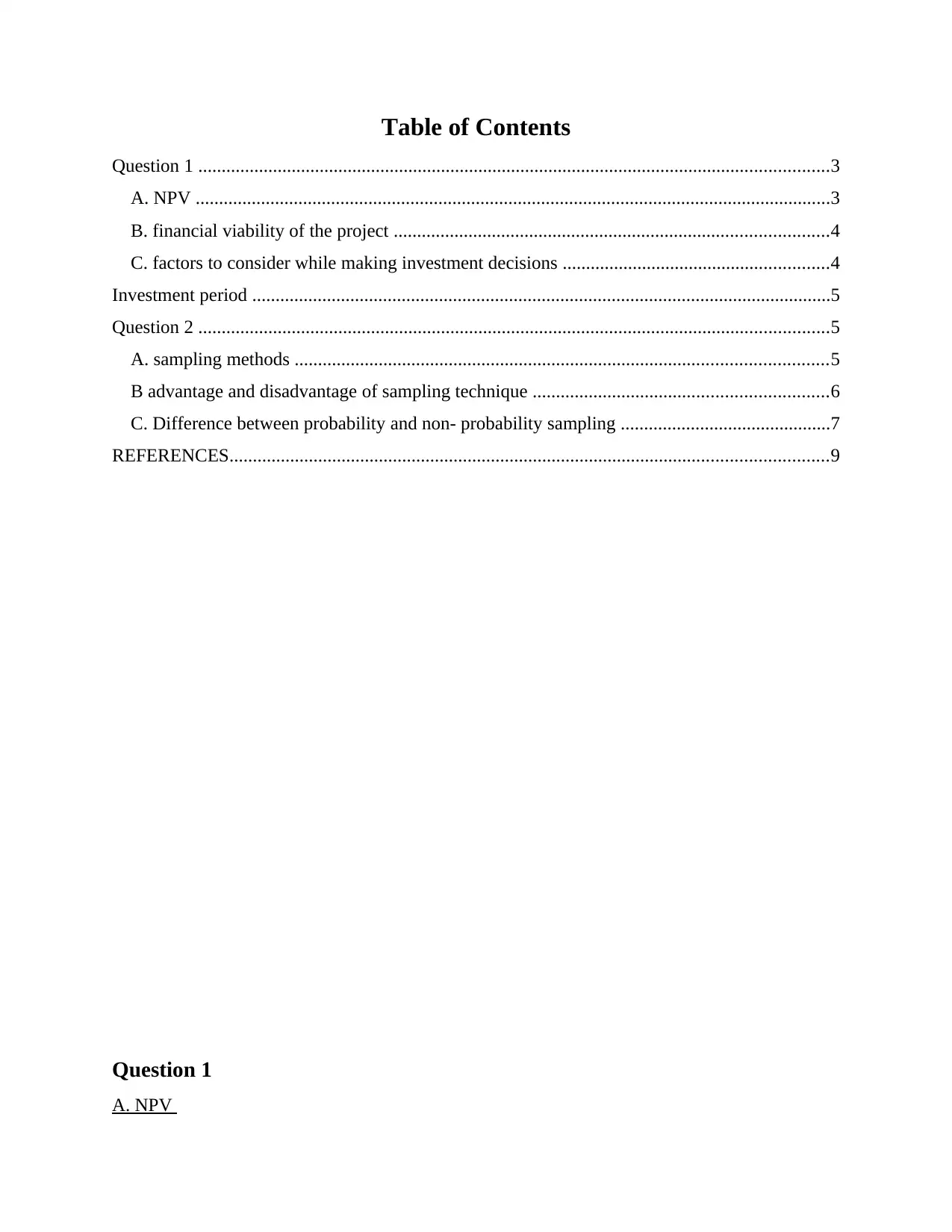
Table of Contents
Question 1 .......................................................................................................................................3
A. NPV ........................................................................................................................................3
B. financial viability of the project .............................................................................................4
C. factors to consider while making investment decisions .........................................................4
Investment period ............................................................................................................................5
Question 2 .......................................................................................................................................5
A. sampling methods ..................................................................................................................5
B advantage and disadvantage of sampling technique ...............................................................6
C. Difference between probability and non- probability sampling .............................................7
REFERENCES................................................................................................................................9
Question 1
A. NPV
Question 1 .......................................................................................................................................3
A. NPV ........................................................................................................................................3
B. financial viability of the project .............................................................................................4
C. factors to consider while making investment decisions .........................................................4
Investment period ............................................................................................................................5
Question 2 .......................................................................................................................................5
A. sampling methods ..................................................................................................................5
B advantage and disadvantage of sampling technique ...............................................................6
C. Difference between probability and non- probability sampling .............................................7
REFERENCES................................................................................................................................9
Question 1
A. NPV
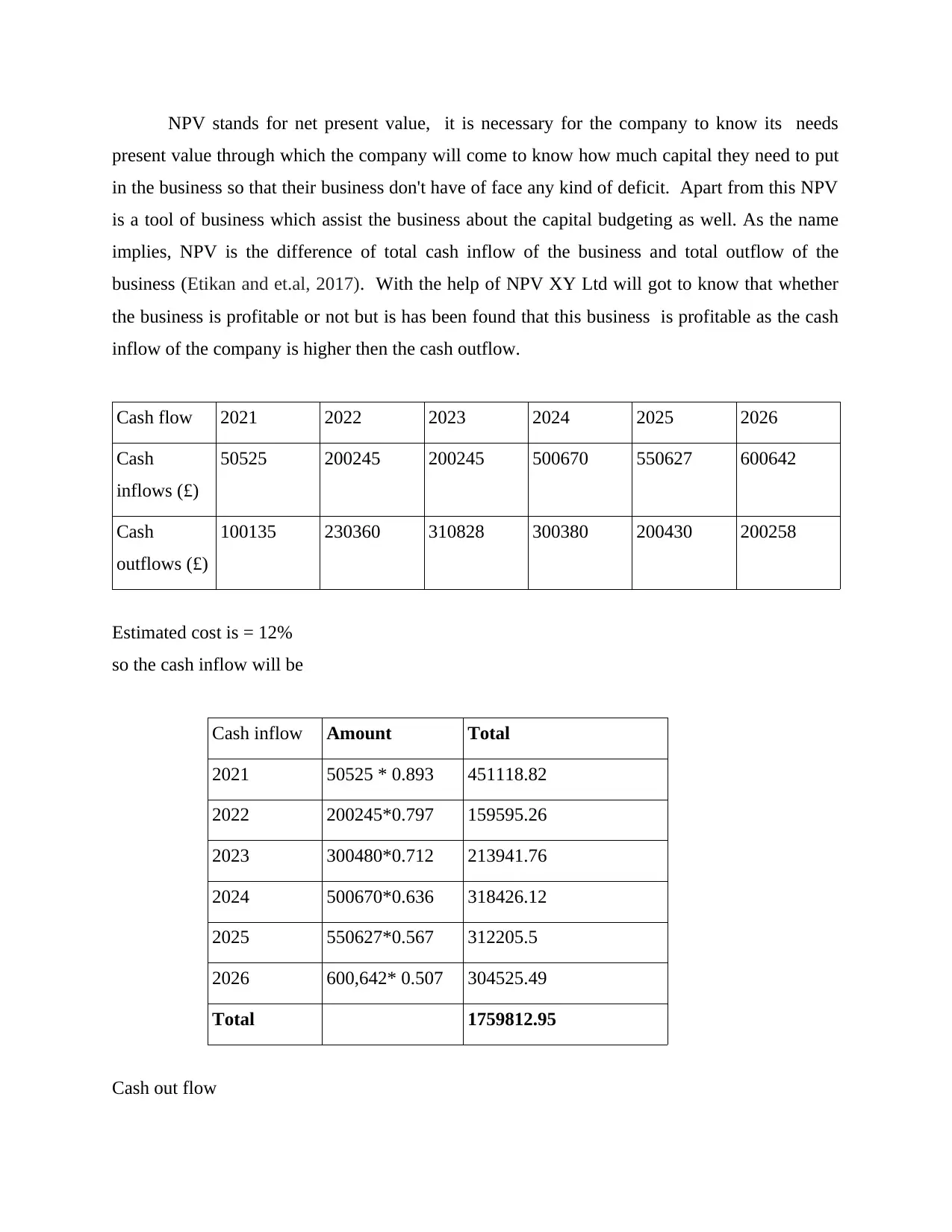
NPV stands for net present value, it is necessary for the company to know its needs
present value through which the company will come to know how much capital they need to put
in the business so that their business don't have of face any kind of deficit. Apart from this NPV
is a tool of business which assist the business about the capital budgeting as well. As the name
implies, NPV is the difference of total cash inflow of the business and total outflow of the
business (Etikan and et.al, 2017). With the help of NPV XY Ltd will got to know that whether
the business is profitable or not but is has been found that this business is profitable as the cash
inflow of the company is higher then the cash outflow.
Cash flow 2021 2022 2023 2024 2025 2026
Cash
inflows (£)
50525 200245 200245 500670 550627 600642
Cash
outflows (£)
100135 230360 310828 300380 200430 200258
Estimated cost is = 12%
so the cash inflow will be
Cash inflow Amount Total
2021 50525 * 0.893 451118.82
2022 200245*0.797 159595.26
2023 300480*0.712 213941.76
2024 500670*0.636 318426.12
2025 550627*0.567 312205.5
2026 600,642* 0.507 304525.49
Total 1759812.95
Cash out flow
present value through which the company will come to know how much capital they need to put
in the business so that their business don't have of face any kind of deficit. Apart from this NPV
is a tool of business which assist the business about the capital budgeting as well. As the name
implies, NPV is the difference of total cash inflow of the business and total outflow of the
business (Etikan and et.al, 2017). With the help of NPV XY Ltd will got to know that whether
the business is profitable or not but is has been found that this business is profitable as the cash
inflow of the company is higher then the cash outflow.
Cash flow 2021 2022 2023 2024 2025 2026
Cash
inflows (£)
50525 200245 200245 500670 550627 600642
Cash
outflows (£)
100135 230360 310828 300380 200430 200258
Estimated cost is = 12%
so the cash inflow will be
Cash inflow Amount Total
2021 50525 * 0.893 451118.82
2022 200245*0.797 159595.26
2023 300480*0.712 213941.76
2024 500670*0.636 318426.12
2025 550627*0.567 312205.5
2026 600,642* 0.507 304525.49
Total 1759812.95
Cash out flow
⊘ This is a preview!⊘
Do you want full access?
Subscribe today to unlock all pages.

Trusted by 1+ million students worldwide

Cash inflow Amount Total
2021 100135* 0.893 89420.55
2022 230360*0.797 183596.92
2023 310828*0.712 221309.53
2024 300380*0.636 191041.68
2025 200430*0.567 113643.81
2026 200258* 0.507 101530.8
Total 900543.29
NPV will be = cash inflow – cash outflow
1759812.95- 900543.29= 859269.66
B. financial viability of the project
Financial viability of the project plays a significant role in the overall project , financial
viability only get judged on the basis of financial data which is available with the company or
business. For example financial viability of any project states that after taking loan will the
project generate profit and surplus for the business or not. As the XY Ltd has invested an initial
amount in the business so the financial viability will assist the company that whether it will gain
the surplus or the business will earn the deficit. The simple meaning of viability is the ability to
survive (MacInnis and et.al,2018). So the financial viability of the project shows the financial
performance and financial position of the business, it shows is the business profitable or not, i9n
the future how much return will be generated by the business, and if the business gain losses then
what the management and owner of the business will manage such losses form the returns and
revenues.
2021 100135* 0.893 89420.55
2022 230360*0.797 183596.92
2023 310828*0.712 221309.53
2024 300380*0.636 191041.68
2025 200430*0.567 113643.81
2026 200258* 0.507 101530.8
Total 900543.29
NPV will be = cash inflow – cash outflow
1759812.95- 900543.29= 859269.66
B. financial viability of the project
Financial viability of the project plays a significant role in the overall project , financial
viability only get judged on the basis of financial data which is available with the company or
business. For example financial viability of any project states that after taking loan will the
project generate profit and surplus for the business or not. As the XY Ltd has invested an initial
amount in the business so the financial viability will assist the company that whether it will gain
the surplus or the business will earn the deficit. The simple meaning of viability is the ability to
survive (MacInnis and et.al,2018). So the financial viability of the project shows the financial
performance and financial position of the business, it shows is the business profitable or not, i9n
the future how much return will be generated by the business, and if the business gain losses then
what the management and owner of the business will manage such losses form the returns and
revenues.
Paraphrase This Document
Need a fresh take? Get an instant paraphrase of this document with our AI Paraphraser
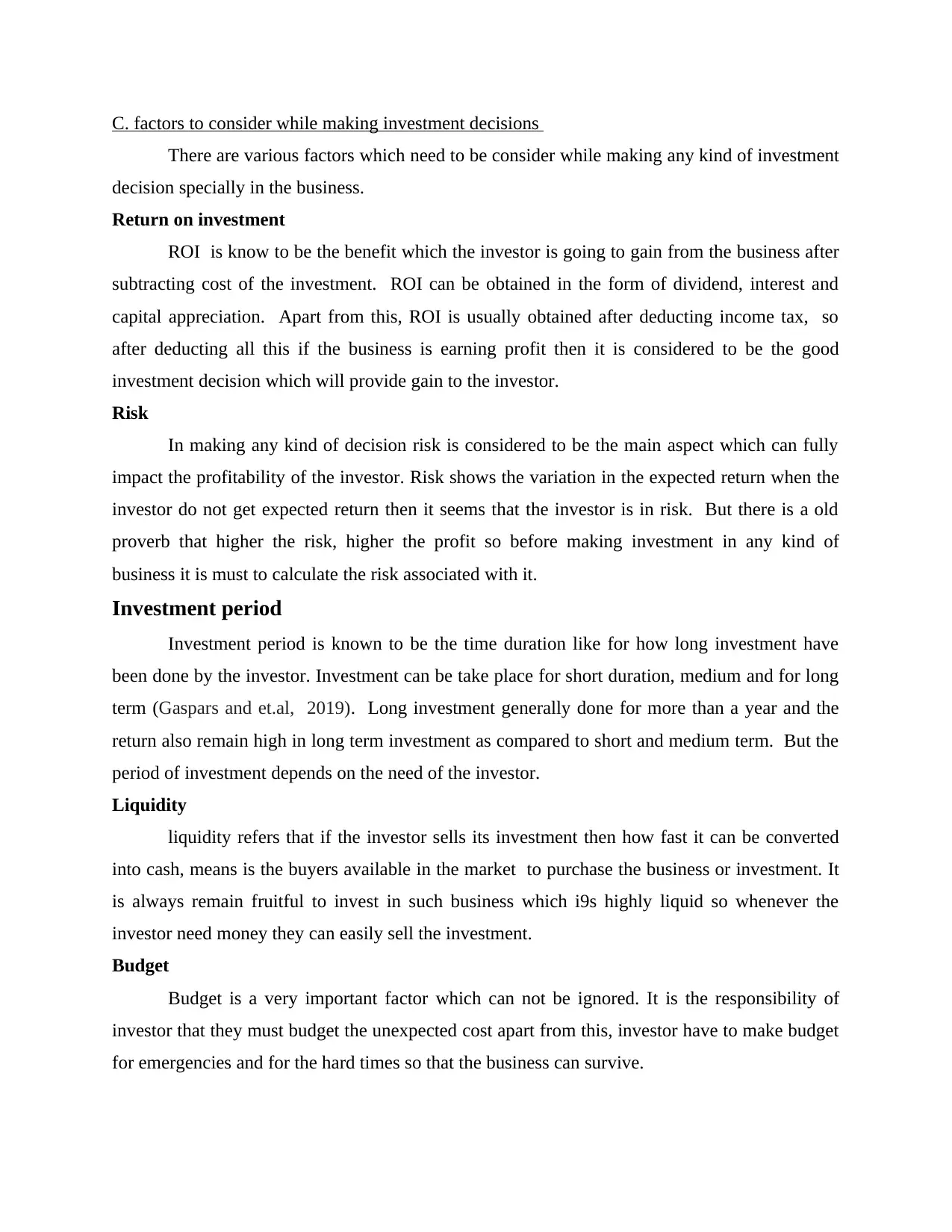
C. factors to consider while making investment decisions
There are various factors which need to be consider while making any kind of investment
decision specially in the business.
Return on investment
ROI is know to be the benefit which the investor is going to gain from the business after
subtracting cost of the investment. ROI can be obtained in the form of dividend, interest and
capital appreciation. Apart from this, ROI is usually obtained after deducting income tax, so
after deducting all this if the business is earning profit then it is considered to be the good
investment decision which will provide gain to the investor.
Risk
In making any kind of decision risk is considered to be the main aspect which can fully
impact the profitability of the investor. Risk shows the variation in the expected return when the
investor do not get expected return then it seems that the investor is in risk. But there is a old
proverb that higher the risk, higher the profit so before making investment in any kind of
business it is must to calculate the risk associated with it.
Investment period
Investment period is known to be the time duration like for how long investment have
been done by the investor. Investment can be take place for short duration, medium and for long
term (Gaspars and et.al, 2019). Long investment generally done for more than a year and the
return also remain high in long term investment as compared to short and medium term. But the
period of investment depends on the need of the investor.
Liquidity
liquidity refers that if the investor sells its investment then how fast it can be converted
into cash, means is the buyers available in the market to purchase the business or investment. It
is always remain fruitful to invest in such business which i9s highly liquid so whenever the
investor need money they can easily sell the investment.
Budget
Budget is a very important factor which can not be ignored. It is the responsibility of
investor that they must budget the unexpected cost apart from this, investor have to make budget
for emergencies and for the hard times so that the business can survive.
There are various factors which need to be consider while making any kind of investment
decision specially in the business.
Return on investment
ROI is know to be the benefit which the investor is going to gain from the business after
subtracting cost of the investment. ROI can be obtained in the form of dividend, interest and
capital appreciation. Apart from this, ROI is usually obtained after deducting income tax, so
after deducting all this if the business is earning profit then it is considered to be the good
investment decision which will provide gain to the investor.
Risk
In making any kind of decision risk is considered to be the main aspect which can fully
impact the profitability of the investor. Risk shows the variation in the expected return when the
investor do not get expected return then it seems that the investor is in risk. But there is a old
proverb that higher the risk, higher the profit so before making investment in any kind of
business it is must to calculate the risk associated with it.
Investment period
Investment period is known to be the time duration like for how long investment have
been done by the investor. Investment can be take place for short duration, medium and for long
term (Gaspars and et.al, 2019). Long investment generally done for more than a year and the
return also remain high in long term investment as compared to short and medium term. But the
period of investment depends on the need of the investor.
Liquidity
liquidity refers that if the investor sells its investment then how fast it can be converted
into cash, means is the buyers available in the market to purchase the business or investment. It
is always remain fruitful to invest in such business which i9s highly liquid so whenever the
investor need money they can easily sell the investment.
Budget
Budget is a very important factor which can not be ignored. It is the responsibility of
investor that they must budget the unexpected cost apart from this, investor have to make budget
for emergencies and for the hard times so that the business can survive.
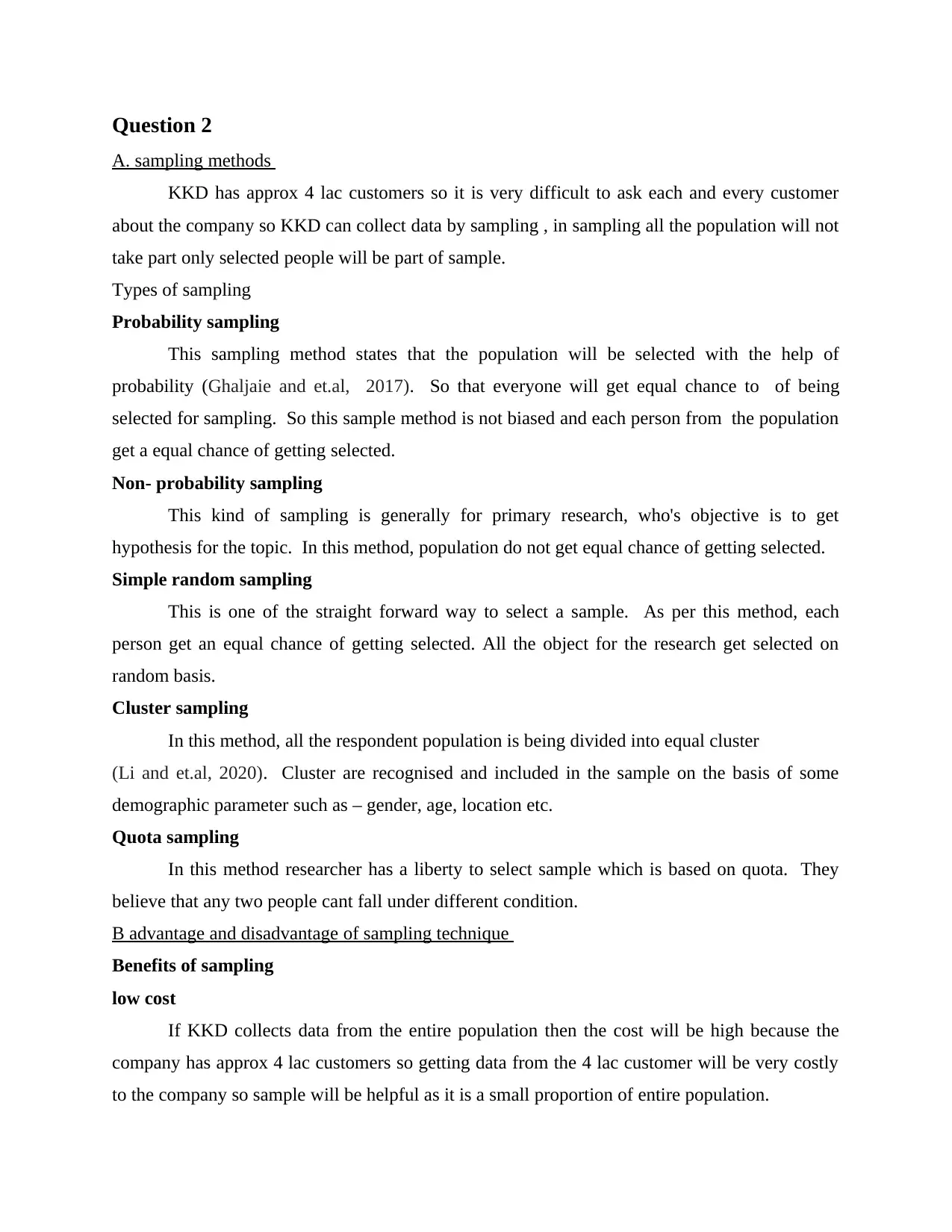
Question 2
A. sampling methods
KKD has approx 4 lac customers so it is very difficult to ask each and every customer
about the company so KKD can collect data by sampling , in sampling all the population will not
take part only selected people will be part of sample.
Types of sampling
Probability sampling
This sampling method states that the population will be selected with the help of
probability (Ghaljaie and et.al, 2017). So that everyone will get equal chance to of being
selected for sampling. So this sample method is not biased and each person from the population
get a equal chance of getting selected.
Non- probability sampling
This kind of sampling is generally for primary research, who's objective is to get
hypothesis for the topic. In this method, population do not get equal chance of getting selected.
Simple random sampling
This is one of the straight forward way to select a sample. As per this method, each
person get an equal chance of getting selected. All the object for the research get selected on
random basis.
Cluster sampling
In this method, all the respondent population is being divided into equal cluster
(Li and et.al, 2020). Cluster are recognised and included in the sample on the basis of some
demographic parameter such as – gender, age, location etc.
Quota sampling
In this method researcher has a liberty to select sample which is based on quota. They
believe that any two people cant fall under different condition.
B advantage and disadvantage of sampling technique
Benefits of sampling
low cost
If KKD collects data from the entire population then the cost will be high because the
company has approx 4 lac customers so getting data from the 4 lac customer will be very costly
to the company so sample will be helpful as it is a small proportion of entire population.
A. sampling methods
KKD has approx 4 lac customers so it is very difficult to ask each and every customer
about the company so KKD can collect data by sampling , in sampling all the population will not
take part only selected people will be part of sample.
Types of sampling
Probability sampling
This sampling method states that the population will be selected with the help of
probability (Ghaljaie and et.al, 2017). So that everyone will get equal chance to of being
selected for sampling. So this sample method is not biased and each person from the population
get a equal chance of getting selected.
Non- probability sampling
This kind of sampling is generally for primary research, who's objective is to get
hypothesis for the topic. In this method, population do not get equal chance of getting selected.
Simple random sampling
This is one of the straight forward way to select a sample. As per this method, each
person get an equal chance of getting selected. All the object for the research get selected on
random basis.
Cluster sampling
In this method, all the respondent population is being divided into equal cluster
(Li and et.al, 2020). Cluster are recognised and included in the sample on the basis of some
demographic parameter such as – gender, age, location etc.
Quota sampling
In this method researcher has a liberty to select sample which is based on quota. They
believe that any two people cant fall under different condition.
B advantage and disadvantage of sampling technique
Benefits of sampling
low cost
If KKD collects data from the entire population then the cost will be high because the
company has approx 4 lac customers so getting data from the 4 lac customer will be very costly
to the company so sample will be helpful as it is a small proportion of entire population.
⊘ This is a preview!⊘
Do you want full access?
Subscribe today to unlock all pages.

Trusted by 1+ million students worldwide
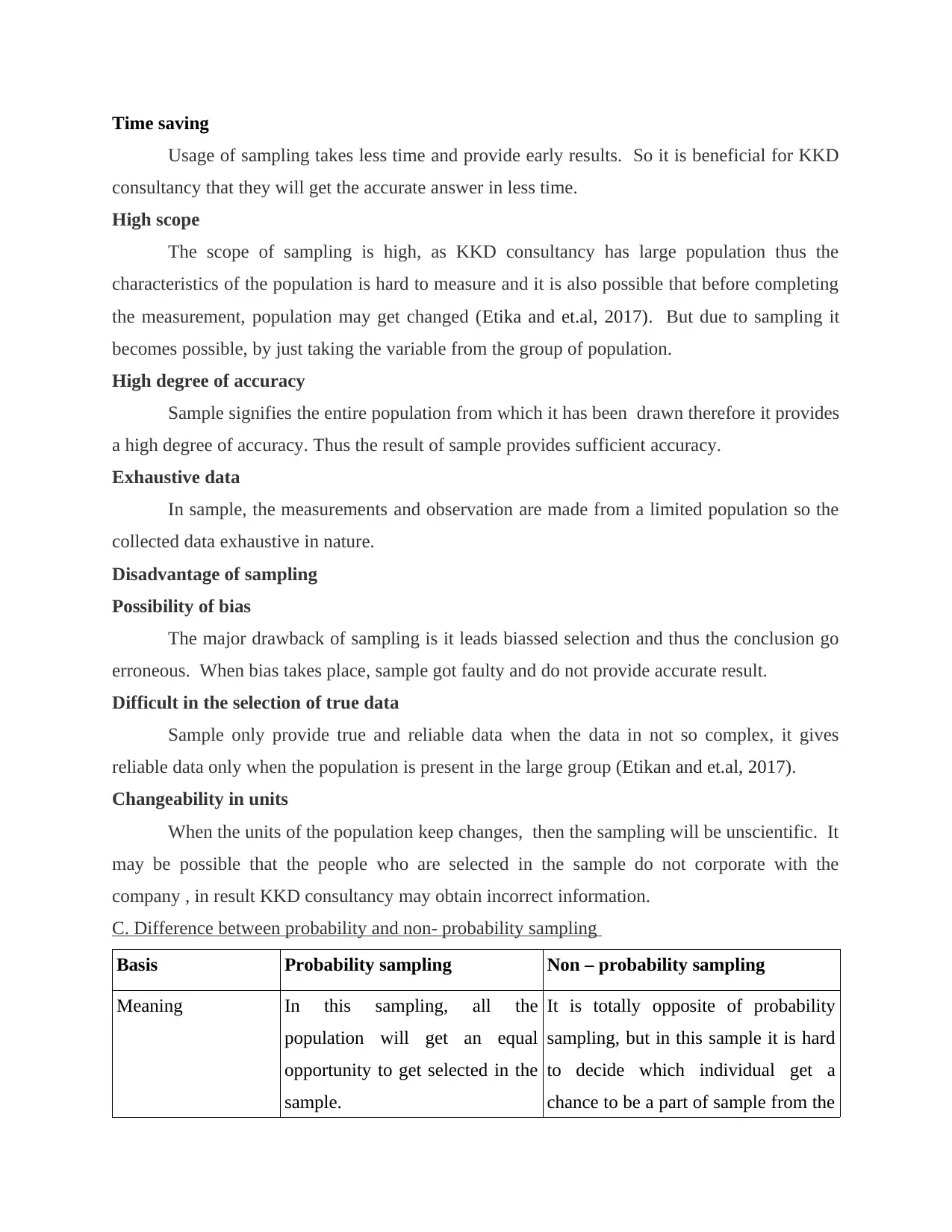
Time saving
Usage of sampling takes less time and provide early results. So it is beneficial for KKD
consultancy that they will get the accurate answer in less time.
High scope
The scope of sampling is high, as KKD consultancy has large population thus the
characteristics of the population is hard to measure and it is also possible that before completing
the measurement, population may get changed (Etika and et.al, 2017). But due to sampling it
becomes possible, by just taking the variable from the group of population.
High degree of accuracy
Sample signifies the entire population from which it has been drawn therefore it provides
a high degree of accuracy. Thus the result of sample provides sufficient accuracy.
Exhaustive data
In sample, the measurements and observation are made from a limited population so the
collected data exhaustive in nature.
Disadvantage of sampling
Possibility of bias
The major drawback of sampling is it leads biassed selection and thus the conclusion go
erroneous. When bias takes place, sample got faulty and do not provide accurate result.
Difficult in the selection of true data
Sample only provide true and reliable data when the data in not so complex, it gives
reliable data only when the population is present in the large group (Etikan and et.al, 2017).
Changeability in units
When the units of the population keep changes, then the sampling will be unscientific. It
may be possible that the people who are selected in the sample do not corporate with the
company , in result KKD consultancy may obtain incorrect information.
C. Difference between probability and non- probability sampling
Basis Probability sampling Non – probability sampling
Meaning In this sampling, all the
population will get an equal
opportunity to get selected in the
sample.
It is totally opposite of probability
sampling, but in this sample it is hard
to decide which individual get a
chance to be a part of sample from the
Usage of sampling takes less time and provide early results. So it is beneficial for KKD
consultancy that they will get the accurate answer in less time.
High scope
The scope of sampling is high, as KKD consultancy has large population thus the
characteristics of the population is hard to measure and it is also possible that before completing
the measurement, population may get changed (Etika and et.al, 2017). But due to sampling it
becomes possible, by just taking the variable from the group of population.
High degree of accuracy
Sample signifies the entire population from which it has been drawn therefore it provides
a high degree of accuracy. Thus the result of sample provides sufficient accuracy.
Exhaustive data
In sample, the measurements and observation are made from a limited population so the
collected data exhaustive in nature.
Disadvantage of sampling
Possibility of bias
The major drawback of sampling is it leads biassed selection and thus the conclusion go
erroneous. When bias takes place, sample got faulty and do not provide accurate result.
Difficult in the selection of true data
Sample only provide true and reliable data when the data in not so complex, it gives
reliable data only when the population is present in the large group (Etikan and et.al, 2017).
Changeability in units
When the units of the population keep changes, then the sampling will be unscientific. It
may be possible that the people who are selected in the sample do not corporate with the
company , in result KKD consultancy may obtain incorrect information.
C. Difference between probability and non- probability sampling
Basis Probability sampling Non – probability sampling
Meaning In this sampling, all the
population will get an equal
opportunity to get selected in the
sample.
It is totally opposite of probability
sampling, but in this sample it is hard
to decide which individual get a
chance to be a part of sample from the
Paraphrase This Document
Need a fresh take? Get an instant paraphrase of this document with our AI Paraphraser
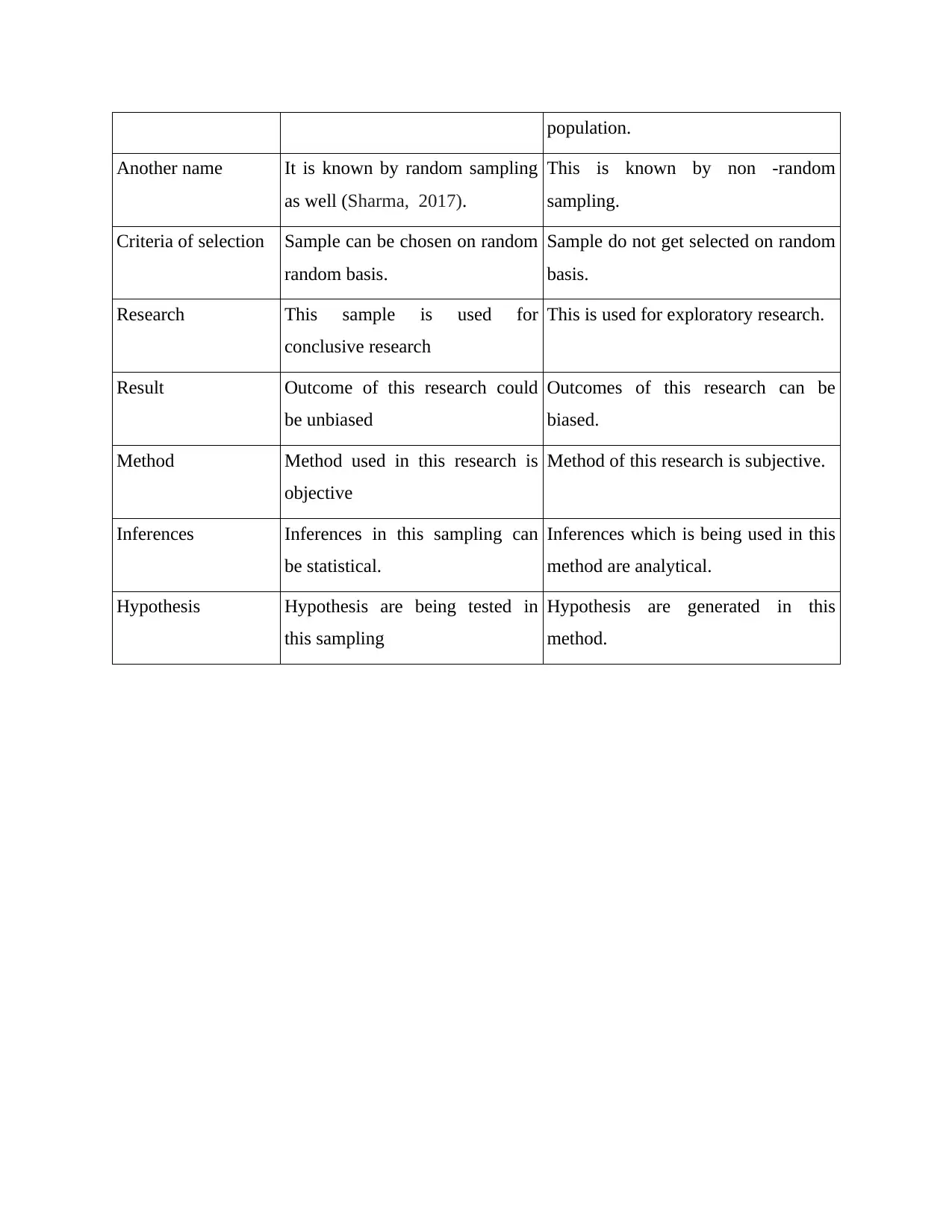
population.
Another name It is known by random sampling
as well (Sharma, 2017).
This is known by non -random
sampling.
Criteria of selection Sample can be chosen on random
random basis.
Sample do not get selected on random
basis.
Research This sample is used for
conclusive research
This is used for exploratory research.
Result Outcome of this research could
be unbiased
Outcomes of this research can be
biased.
Method Method used in this research is
objective
Method of this research is subjective.
Inferences Inferences in this sampling can
be statistical.
Inferences which is being used in this
method are analytical.
Hypothesis Hypothesis are being tested in
this sampling
Hypothesis are generated in this
method.
Another name It is known by random sampling
as well (Sharma, 2017).
This is known by non -random
sampling.
Criteria of selection Sample can be chosen on random
random basis.
Sample do not get selected on random
basis.
Research This sample is used for
conclusive research
This is used for exploratory research.
Result Outcome of this research could
be unbiased
Outcomes of this research can be
biased.
Method Method used in this research is
objective
Method of this research is subjective.
Inferences Inferences in this sampling can
be statistical.
Inferences which is being used in this
method are analytical.
Hypothesis Hypothesis are being tested in
this sampling
Hypothesis are generated in this
method.
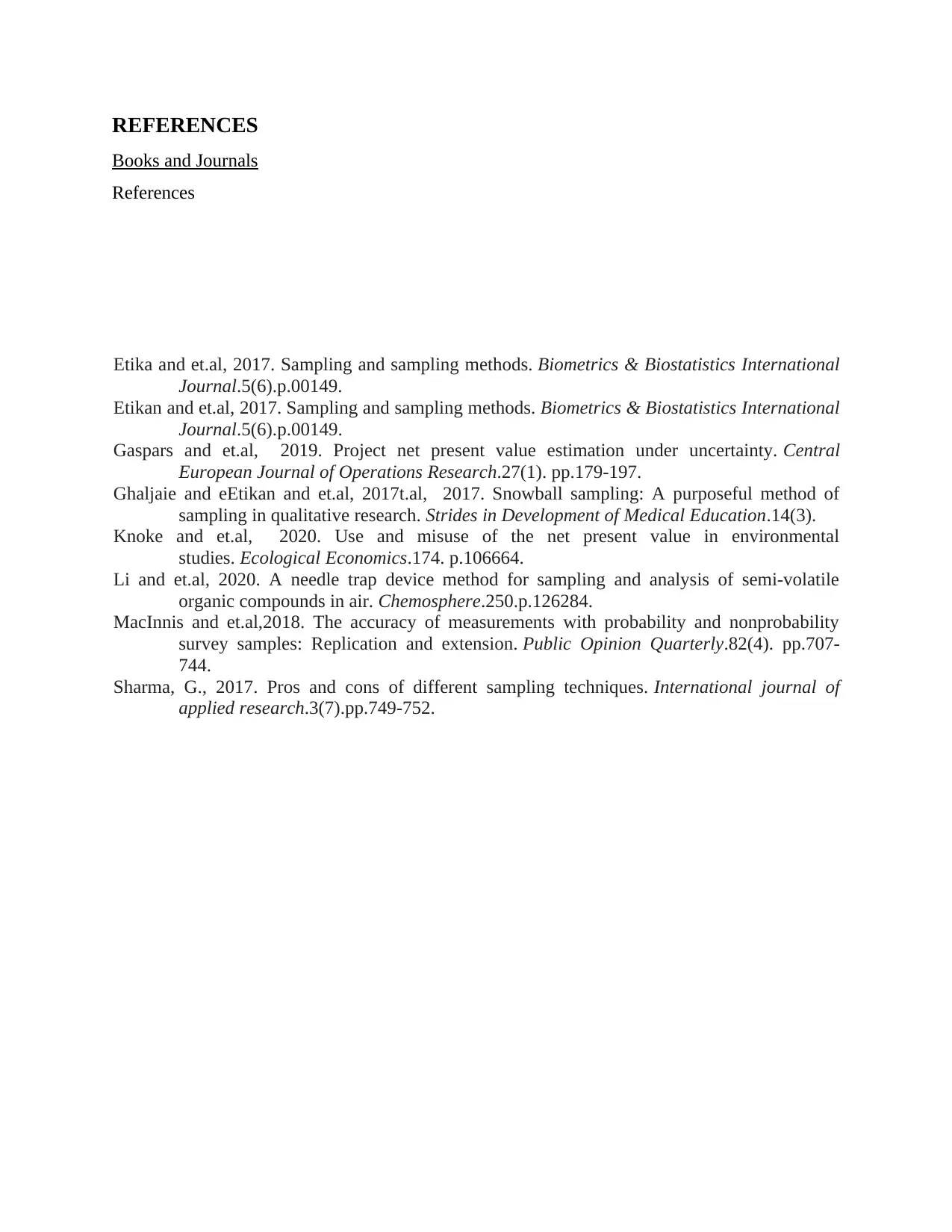
REFERENCES
Books and Journals
References
Etika and et.al, 2017. Sampling and sampling methods. Biometrics & Biostatistics International
Journal.5(6).p.00149.
Etikan and et.al, 2017. Sampling and sampling methods. Biometrics & Biostatistics International
Journal.5(6).p.00149.
Gaspars and et.al, 2019. Project net present value estimation under uncertainty. Central
European Journal of Operations Research.27(1). pp.179-197.
Ghaljaie and eEtikan and et.al, 2017t.al, 2017. Snowball sampling: A purposeful method of
sampling in qualitative research. Strides in Development of Medical Education.14(3).
Knoke and et.al, 2020. Use and misuse of the net present value in environmental
studies. Ecological Economics.174. p.106664.
Li and et.al, 2020. A needle trap device method for sampling and analysis of semi-volatile
organic compounds in air. Chemosphere.250.p.126284.
MacInnis and et.al,2018. The accuracy of measurements with probability and nonprobability
survey samples: Replication and extension. Public Opinion Quarterly.82(4). pp.707-
744.
Sharma, G., 2017. Pros and cons of different sampling techniques. International journal of
applied research.3(7).pp.749-752.
Books and Journals
References
Etika and et.al, 2017. Sampling and sampling methods. Biometrics & Biostatistics International
Journal.5(6).p.00149.
Etikan and et.al, 2017. Sampling and sampling methods. Biometrics & Biostatistics International
Journal.5(6).p.00149.
Gaspars and et.al, 2019. Project net present value estimation under uncertainty. Central
European Journal of Operations Research.27(1). pp.179-197.
Ghaljaie and eEtikan and et.al, 2017t.al, 2017. Snowball sampling: A purposeful method of
sampling in qualitative research. Strides in Development of Medical Education.14(3).
Knoke and et.al, 2020. Use and misuse of the net present value in environmental
studies. Ecological Economics.174. p.106664.
Li and et.al, 2020. A needle trap device method for sampling and analysis of semi-volatile
organic compounds in air. Chemosphere.250.p.126284.
MacInnis and et.al,2018. The accuracy of measurements with probability and nonprobability
survey samples: Replication and extension. Public Opinion Quarterly.82(4). pp.707-
744.
Sharma, G., 2017. Pros and cons of different sampling techniques. International journal of
applied research.3(7).pp.749-752.
⊘ This is a preview!⊘
Do you want full access?
Subscribe today to unlock all pages.

Trusted by 1+ million students worldwide
1 out of 9
Related Documents
Your All-in-One AI-Powered Toolkit for Academic Success.
+13062052269
info@desklib.com
Available 24*7 on WhatsApp / Email
![[object Object]](/_next/static/media/star-bottom.7253800d.svg)
Unlock your academic potential
Copyright © 2020–2025 A2Z Services. All Rights Reserved. Developed and managed by ZUCOL.





